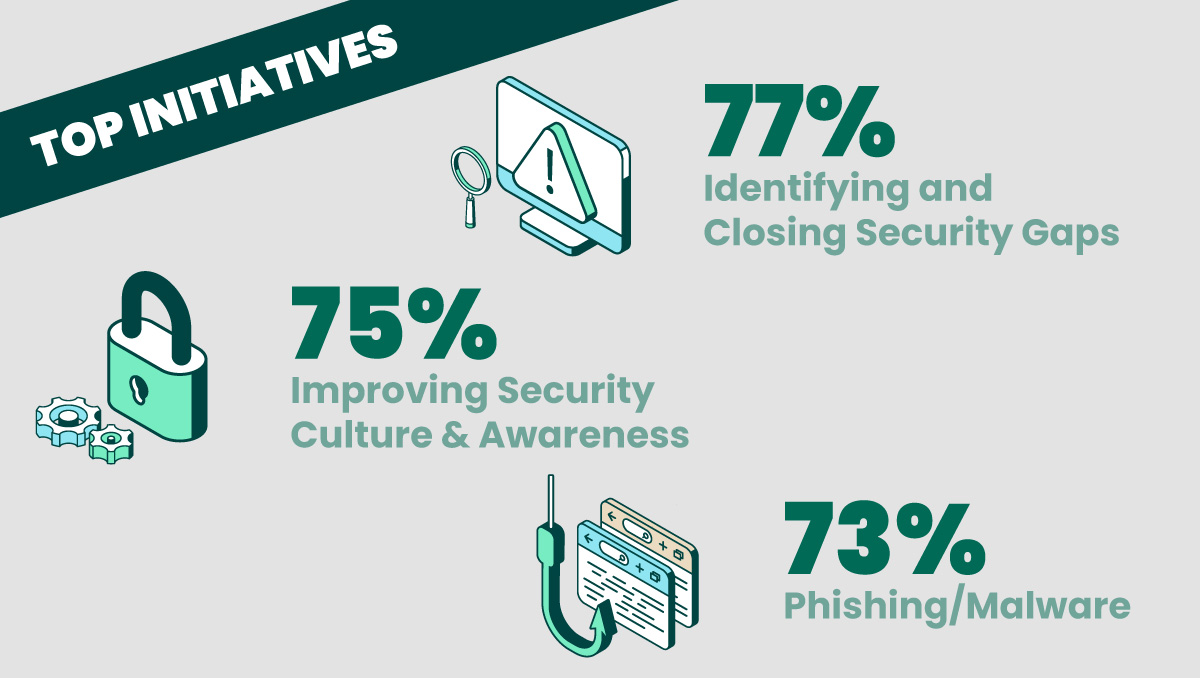It’s difficult to plan ahead if we don’t know what’s behind. This year’s Fortra 2025 State of Cybersecurity survey results revealed some of the most pressing concerns weighing on practitioners’ minds for the past twelve months. If we look closely, we can start to see the cybersecurity trends begin to change over time.
It may come as no surprise that artificial intelligence (AI) and its associated developments accounted for much of the shift in concern, as comparisons to the 2024 report will reveal. But the most important thing to note is how organizations are planning to increase their cybersecurity maturity to respond to these challenges, and what that means for strategic planning in the year ahead.
Top Security Risks and Trends
Across the board, these five attack vectors proved to be top-of-mind for the majority of surveyed cybersecurity professionals in Fortra’s most recent State of Cybersecurity report:
1. Phishing/Smishing
Phishing is a perennial challenge, but thanks to GenAI it has become a bigger – and more serious – threat than ever. This year's numbers reflect that, with an increase from 81% to 83%. Although slight, you’d think that the increased adoption of stronger anti-phishing tools like integrated cloud email security (ICES) would cause fear of phishing abuse to go down. However, as other figures will show, there is reason to believe that GenAI and its capability for near-flawless social engineering is still managing to keep ahead of industry gains.
2. Malware/Ransomware
If attackers have their way, malware (and ransomware in particular) is one cybersecurity trend that is never going out of style. While tactics evolve, these exploits are a tried-and-true danger for organizations, and the numbers reflect that. In the 2025 report, nearly three quarters (71%) of professionals ranked malware/ransomware as their second-greatest security risk. Interestingly, this number represented a slight decrease from last year (76%), which could reflect better malware detection engines doing their job. This follows the logic of more anxiety over phishing and social engineering threats (as we’ll see), because powerful signature-based detection tools and XDR platforms are getting more adept at catching ransomware in the wild.
3. Social Engineering
Participants ranked social engineering as a more threatening risk factor this year than last, with an increase of 5%. This can include anything from job fraud on LinkedIn to QR code scams and Business Email Compromise (BEC) attacks. Fortra’s most recent BEC Global Insights Report: January 2025 revealed a 10% uptick in BEC scams from the month before, with international (non-US) banks being the primary target of choice for wire transfer scammers (accounting for 30% of all such attacks). According to the report, the average wire transfer amount requested has gone up, too; rising from $16,799 in December to $24,586 this January.
Another interesting cybersecurity trend worth noting is the fact that “Evolving Technology” was a top concern for 50% of participants this year, indicating a 15% spike from the modest 35% it garnered last year. As more advanced AI capabilities continue to roll out, it makes sense that it would be an increased cause for concern. These capabilities lead directly into social engineering:
Deepfakes
Word-perfect emails in any language
Highly customized AI-created phishing campaigns
And more. The trick is for cybersecurity providers to leverage AI in equally effective ways.
4. Cybersecurity Initiatives
More interesting 2025 cybersecurity trends continue; despite diligent security efforts by established security frameworks to modernize and keep pace with current threats, even the most trusted standards like NIST are only getting moderate adoption rates: 54% for NIST, the top contender, and even that is down by 5% from last year. Do today’s companies really trust these frameworks to keep up? Or are efforts being diverted to in-house zero trust initiatives and compliance frameworks that are non-optional?
Fortra’s Annual Cybersecurity Survey
Now in its second year, Fortra’s annual State of Cybersecurity Survey canvasses opinions from professionals in over two dozen industries and across the globe, gathering facts and analyzing the latest cybersecurity trends. To compare this year’s data with last year’s trends, check out last year’s 2024 State of Cybersecurity Survey report. Remember, the best way to plan ahead is by knowing what’s behind.
Check out the latest 2025 cybersecurity trends for yourself.
Download your copy of the Fortra 2025 State of Cybersecurity Survey results now.
